5 Reasons Why That 5-Star Recipe May Have Flopped When You Made It
Have you ever gathered ingredients and hyped yourself up to make a super popular recipe only to have it flop or fail to impress?
If so, you aren’t alone. It happens to the best of us. 🙂
As much as I wish that every recipe on my blog was failproof and foolproof and resulted in perfect success for everyone, unfortunately, that just isn’t the case.
Even the most highly rated recipes on my blog and across the web-o-sphere end up disappointing at least a few people.
Let me show you a few real world examples of this.
Exhibit A.
Take this uber-popular Sweet and Sour Chicken recipe. It’s easily one of the most popular recipes on my site with over 400 5-star reviews. And it’s a huge family favorite.
But you can see below that Ted, who took the time to comment, said: “So so…I followed instructions as specified, but resulting taste was not really comparable to how a Chinese restaurant makes it. Will not try again.”
Right below him, however, (and throughout the rest of the comment and rating thread) are tons of 4- and 5-star reviews. This doesn’t delegitimatize Ted’s review. It simply makes me wonder why he didn’t love it when so many others do.
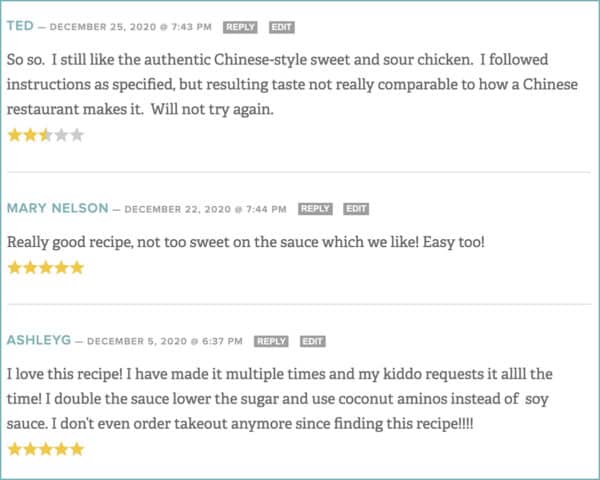
Exhibit B.
Here’s a snippet from the reviews on my favorite French Bread recipe. This particular recipe has over 1,500 5-star reviews. And yet, it still doesn’t work out for everyone.
Naomi said it was “Horrible. Dry and Crumbly. Worst recipe ever.”
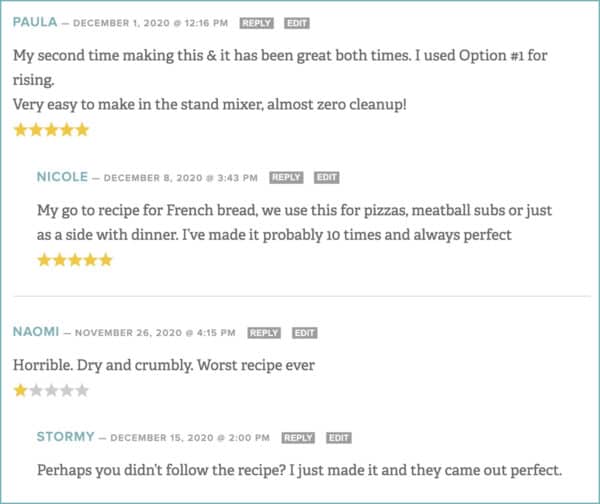
Exhibit C.
Last one. (I could go on and on, but we have more important things to discuss.) The Best Blackberry Crisp. This recipe has over 300 5-star reviews.
Below in the screenshot, you can see that Deborah reports it is the best crisp she’s ever made. But right below that, Sharon reports that she made it twice, it didn’t work out either time, AND it didn’t look like the pictures in my post.
It’s clear Sharon wanted to love it, but it just didn’t work out.
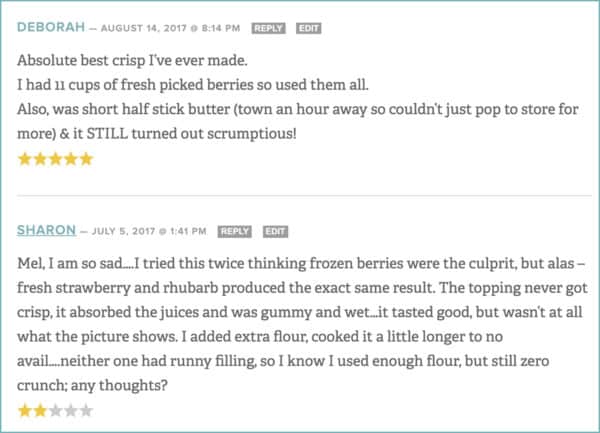
How does this happen? Why would a tried-and-tested recipe fail? WHAT IS THE MEANING OF LIFE??
After 12 years of blogging, over 200,000 comments, 100,000 recipe ratings, and a VERY scientific analysis plus a peek into the cooking successes and failures of humanity as a whole, I have a few ideas about why this sometimes happens.
A quick note before we dive in: As you read the suggestions below, please understand, I am not suggesting that if a recipe doesn’t work out, it’s all because of you. Sometimes, it’s 100% the recipe’s fault. It isn’t written well. It hasn’t been tested. It’s missing an ingredient. My recipes are not immune to problems, either, although I try very hard to make sure they are as foolproof as possible.
This post isn’t about placing blame, it’s about trying to give tips and troubleshoot to help us all feel like rock stars in the kitchen.
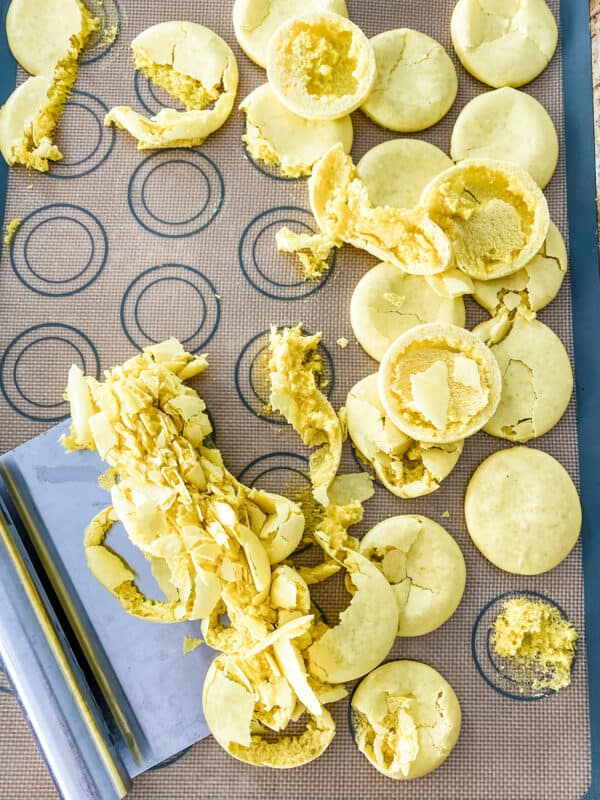
I am hereby proposing FIVE reasons why that 5-star may have flopped when you made it.
#1: Location
THE ISSUE: Location can be a significant factor in cooking…but especially in baking successes and failures.
Humidity, elevation, temperature (inside and outside) can impact a recipe for good or for bad. For instance, when making bread, if you live in a really humid climate, often times you need less water in the recipe. Whereas in a really dry climate, more water may be needed for proper bread hydration.
Rainy/humid weather can be problematic to recipes like macarons and other baked goods.
Elevation can also wreak havoc on cakes and cookies. A cake tested and made near sea level might turn out just fine, but if the same recipe is made at 5,000 feet, it could very well fall or even overflow over the sides of the pan while baking.
There are many more location factors that can play into this. So how do you combat this?
THE SOLUTION: make sure if you live at high elevation that a recipe has been tested at high elevation OR that there are trustworthy reviews of others who have made it at high elevation. I’m not an expert on high elevation baking, but there are a lot of great resources online if you google “high elevation baking.”
Also, know your recipe source. If the blogger you follow lives at sea level and you live at 6,500 feet, it may not be a match made in heaven for the two of you without investing in couples therapy and making many recipe adjustments.
The other solution is a bit painful, but it’s practical and it works. Trial and error. After a few attempts at making certain things (like cookies or bread) in a highly humid or desert climate (or in a freezing cold or super hot house), you’ll start learning what adaptations you need to make to have success. Pro tip: save your sanity and avoid super particular and finicky recipes if you know they tend not to fare well in your climate/area.

#2: Method of Measuring + Mixing
THE ISSUE: There’s a good chance if you ask 10 people to measure out a cup of flour, you’re going to observe 10 different methods for measuring that flour.
Spoon and sweep. Fluff and scoop. Dip and shake. We all have slightly different methods.
The same could be said for measuring brown sugar (how much muscle do you use to pack that stuff into the measuring cup anyway??) or chocolate chips (not gonna lie, I almost always eyeball these instead of measuring).
Even just several tablespoons too much (or too little) flour can seriously mess up a baking recipe. Here’s a post specific to measuring flour that might be helpful.
Mixing certain batters or doughs can also be a bit problematic. Over mixing muffin batter usually means death to fluffy, tender muffins. Same goes for a lot of cakes. And how much does bread dough really need to be kneaded?
Additionally, using a wooden spoon and bowl in stead of an electric mixer can affect a recipe. And speaking of electric stand mixers, there are a lot of variances between different brands and models! (Like Bosch vs KitchenAid)
My goodness, what’s a home baker to do??
THE SOLUTION: Assuming the recipe you are using has been tested (and it should be!), follow the guidelines of that particular recipe. If the recipe author says to spoon and level the flour, don’t use your own personal method of dipping and shaking or else you are going to pack too much flour into the cup.
Over the years, I’ve started using a kitchen scale to test my recipes and to make other recipes; it’s life changing. I have had this scale for years and love it (aff. link).
Using a scale takes the guesswork out of how much flour or brown sugar or whatever should actually be in the measuring cup (and subsequently end up in the recipe).
But what do you do if a recipe doesn’t give weight measures? Or you don’t have a kitchen scale?
Look for clues in the recipe/post/reviews that indicate how it was tested. Does the recipe author generally talk about how they measure ingredients? If not, do your best using the methods you are familiar with. If the recipe doesn’t work out, and you want to make it again, troubleshoot with adjustments.
Here are a few ideas:
- If cookies are flattening grotesquely when baking, add 1/4 to 1/2 cup more flour OR increase the baking temperature by 25 degrees
- Conversely, if cookies are staying in mounds and not flattening at all, reduce the flour amount by 1/4 to 1/2 cup
- If freeform bread or rolls are flattening or falling while rising, add 1/2 cup or so more flour next time to the dough (speaking of yeast doughs, try not to adhere so specifically to the flour amount in the recipe – instead judge the dough by the look and feel, because yeast doughs are particularly susceptible to environmental factors like humidity and elevation)
- If muffins are tough and dry, don’t over mix – in fact, it’s ok if there are a few dry streaks remaining or the batter is a bit lumpy (also, if you tend to pack flour into the measuring cup, measure with a lighter hand and that will help, too)
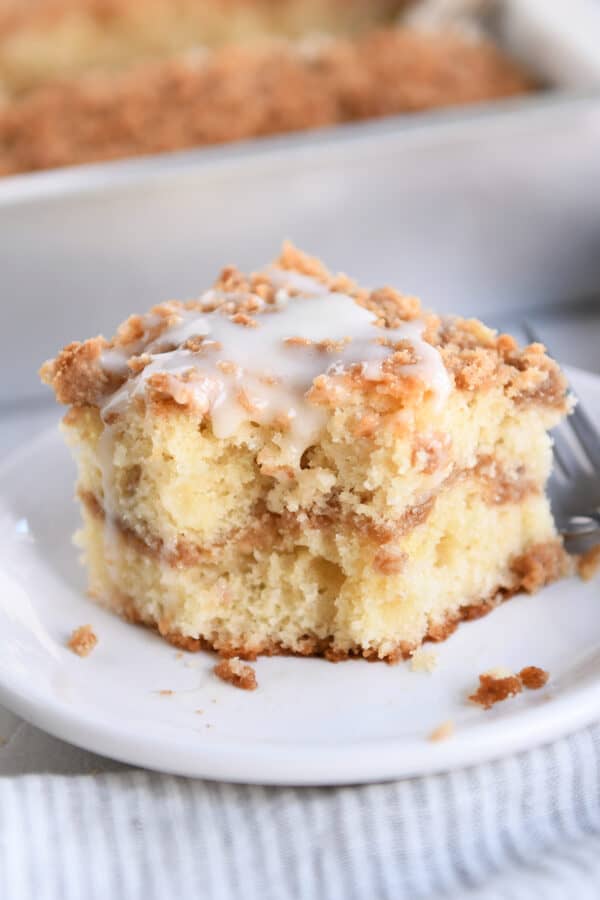
#3: Taste Buds
THE ISSUE: You find a super popular recipe, you make said super popular recipe, and tragically, it is just meh. Or even worse, it tastes awful, and you can’t even finish it (pan over to family gagging at the dinner table).
It looks pretty and you’re 100% certain you made it correctly, but it just doesn’t taste good.
How could this happen when there are so many rave reviews on the recipe?
The truth is, sometimes we just have different taste preferences when it comes to food.
I have had several experiences where someone has given me a recipe swearing up and down on their grandma’s favorite gingham apron that it is the best thing they’ve ever eaten…only to make it myself and wonder what I did wrong (and then try and avoid face-to-face interaction with that person for years because I don’t want to have an awkward conversation about how I made their family favorite heirloom recipe that their sweet granny invented and named after them, and it was kind of not so good).
On my blog, there are comments from people who say they despised the flavors or taste of a certain recipe – or that it turned out *just ok* but doesn’t deserve a remake – even though there are hundreds of people above and below them stating it was the best thing they have ever eaten.
What gives?
THE SOLUTION: Honor your taste buds. It’s tempting to want to make every 5-star recipe that you see, especially if you have a fear of missing out on the next greatest recipe to hit the planet.
But it’s also ok (and really important) to think long and hard about whether a recipe fits your taste preferences. If you are a fan of more complex flavor profiles, maybe avoid recipes that use a lot of semi-homemade substitutions and stick with recipes that use flavorful spices and marinades.
If you don’t like cinnamon in savory dishes or you aren’t a fan of curry, avoid recipes that call for it! If you’ve hated it the last 15 times you’ve tried it, chances are, you will still detest it on the 16th go round.
Of course you aren’t going to know at the onset if every recipe is going to be a home run or not. Sometimes you have to take risks (and sometimes those risks pay off!), but it’s also ok to see a viral recipe come across your feed and say “yeah, nope, don’t think that one is for me.”
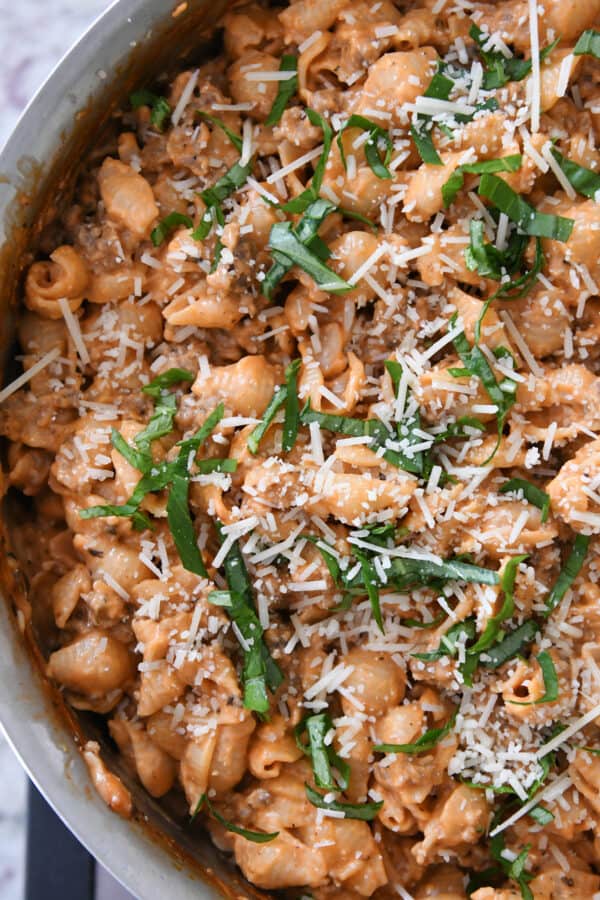
#4: Adaptations
THE ISSUE: Listen, I’m the very first one in the kitchen to start messing with a recipe. In fact, I think there is something in my DNA that won’t allow me to make a recipe as-is. (Also, I hate grocery shopping, so more often than not, I’m making substitutions out of sheer necessity rather than creativity.)
But with that, I’ve had many a “pride goeth before the fall” experience.
As I am looking at the lump of greasy goo that should have been 12 cookie, the little angel (or maybe it’s the devil) on my shoulder is very often whispering : Yeah, Mel, maybe the recipe author DID know better than you, and that’s why they didn’t sub molasses for mashed banana or quinoa for quick oats or natural peanut butter for nutella.
Even small substitutions like skim milk for 2% milk or milk chocolate for unsweetened chocolate or gluten-free flour for all-purpose flour can significantly alter a recipe.
Adapting any tried-and-tested recipe is going to affect the outcome, for better or for worse.
THE SOLUTION: I am definitely not against adapting a recipe. In fact, I’m 100% for it! As long as you and I are willing to take responsibility for the resulting success or failure.
My recommendation (do as I say, not as I do) is to make a recipe as written the first time you make it and then decide what adaptations you want to employ after you taste and assess.
If you have to make substitutions based on food allergies or available ingredients, just keep in mind that the recipe may not mimic the rave reviews that prompted you to try it in the first place.
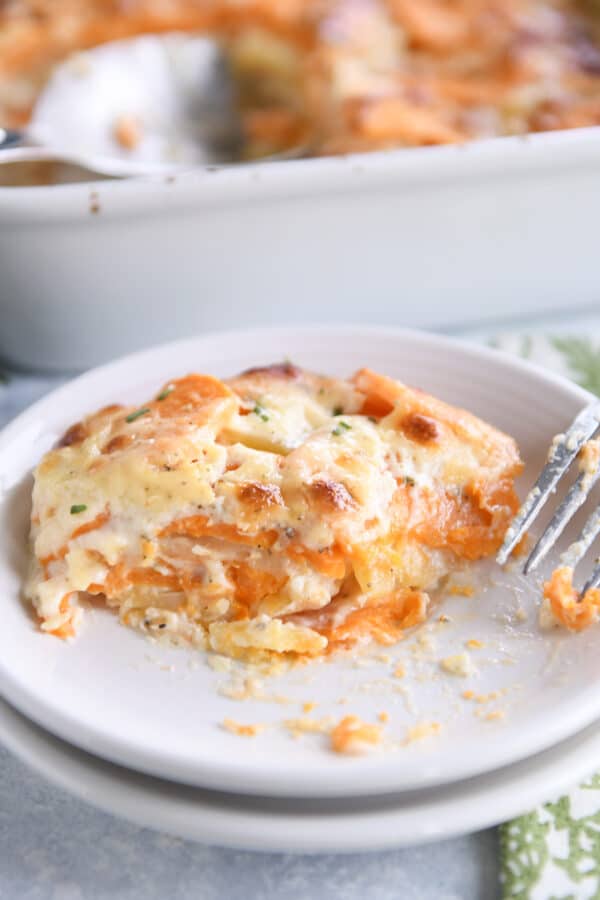
#5: Ingredients
THE ISSUE: It should be obvious, but I think we’ve all been guilty of this at one point or another.
Expired ingredients in any form need to be expunged from the depths of refrigerators and spice cabinets immediately. Make it your weekend project.
Particularly, ingredients like baking powder and yeast can cause major issues in baked goods if they are expired.
When is the last time you went through your spices and checked expiration dates? This is always a slightly horrifying process for me. The last time I did it, I had six (six!) small containers of dried oregano hiding in my spice cupboard, and three of them had expired two years earlier. #yikes #nojudging #pleasetellmeyoudothistoo
Expired spices can leave an otherwise flavorful dish completely lackluster and boring. Expired milk or cream (see the picture caption above, so gross) can leave an otherwise creamy dish completely sour and curdled.
On a slightly different note, if a recipe calls for a specific type of ingredient or asks that the ingredient be at room temperature or cold from the fridge, swallow your pride, and obey the blogger. 🙂
Chances are that this recipe has been tested specifically for these types of variables. Using cold eggs when a recipe calls for room temperature eggs, for instance, or using melted butter instead of softened butter can make a big difference in the outcome.
THE SOLUTION: Check expiration dates before using ingredients!
And also, for all that is good and virtuous in the world, follow the recipe guidelines for ingredient details (temperature of ingredients, etc).
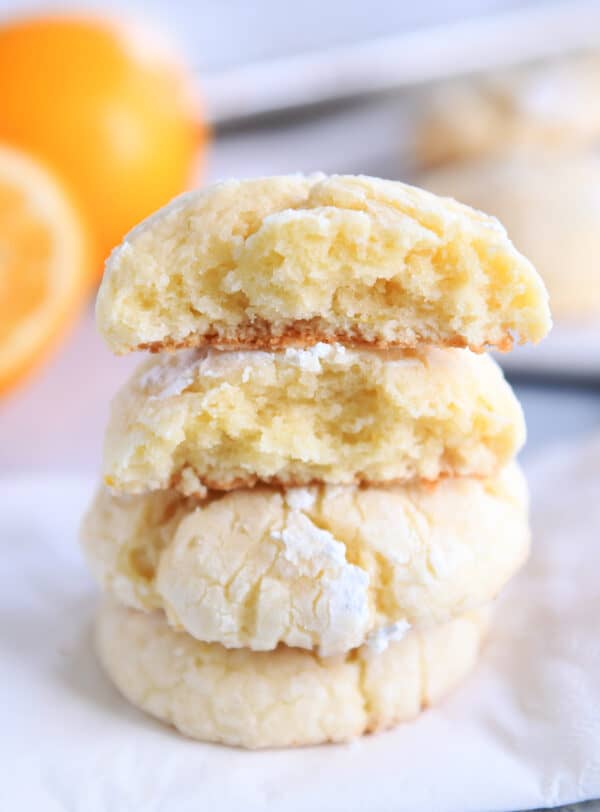
BONUS PRO TIP: Read the reviews.
I can’t understate the importance of this bonus tip.
I wish I didn’t have to bring it up, but reality is reality. And unfortunately in the online space of recipe sharing, there is a huge competition between website owners.
Everyone wants get into that coveted #1 spot on google (or at the very least, on the first page of search results).
This is a valid goal! Trust me. I get excited when my recipes make it in those spots, too!
One of the many ways (it’s not the only way) to do this is to ensure the recipe has reviews. A lot of them. And a lot of high reviews (4- and 5-stars). Sadly, many recipe ratings and reviews you see online aren’t from real people who actually made the recipe. The ratings can be inflated a number of different ways.
If you come across a recipe that shows lots of high star ratings, scroll down to the comments and see what’s going on there. If comments are nonexistent, or there are very few with actual feedback (comments that say things like: “looks amazing!” shouldn’t be giving the recipe a 5-star rating), exercise caution in deciding whether this recipe is worth your time.
I’m not saying it’s automatically a bad recipe or you shouldn’t make it. I’m just saying the star ratings and reviews may not be entirely accurate.
I’d much rather make a recipe that had zero ratings and zero reviews than risk making a recipe that had 48 5-star ratings with no actual written reviews to back it up.
As someone who works very hard to test every single recipe multiple times, I am so, so grateful for all of you who take the time to leave a rating – but more importantly – leave a review with helpful and valid feedback.
It lends authenticity and trustworthiness to the recipes on my website, and I appreciate it so much. I know others who come here looking for a tested recipes appreciate it, too.
I don’t scrub or delete any reviews or comments, even if they are less than favorable (I even leave many of the mean and hateful reviews up – mostly for entertainment), because I think it’s tremendously valuable for you to get a whole picture of whether a recipe might be worth making or not.
So consider this your friendly girl-next-door bloggerly advice to examine recipes and recipe reviews with a gently critical eye.
Thanks for coming to my Ted Talk.
Phew! This post took on a life of its own, and you deserve a lifetime supply of mail order dark chocolate if you made it to the end.
I get comments and questions from people now and again about why a recipe they tried didn’t work out, and I hope this post has some helpful information to troubleshoot the why, the how, and the where to go from here.
There’s no way to ever guarantee a recipe will turn out perfectly the first or second or third time, but there are a lot of ways to maximize the success of a tried-and-tested recipe! You’ve got this.
I just want you to know that I think you are a rock star. Thank you for being here! For making the recipes on this blog. For your patience. And for just being completely and utterly awesome. Love your guts.

Great article! Thanks so much.
GREAT POST! Here’s something I found changes results. I have purchased different brands of ingredients and sometimes they too change the end product. What are their ingredients? Consider the additives in things like applesauce, ketchup etc. does it have added sugar, or other ingredients that may change the flavor or sweetness? Some name brand spices are much more robust than spices you buy at the Dollar Store. Just some things I’ve notice when cooking.
I love all the tips you gave!! I’ve had some of your recipes flop a bit (user error) and others be ahhhmazing!! Despite the flops, I love visiting your site and trying new things!!!
I’ve been waiting for Someone to do a post like this! Thank you! For the record, I just found your site this week when I suddenly had 5 cups of wild blackberries and was gonna make a cobbler. But after two days of dithering, I saw your Blackberry Crisp and went with that. Read many of the reviews first-the Absolutely delicious! And the Too much butter ones both. Well. It was delicious and the crust was crisp. Lovely. But I’ve been down the other path too…did a Chris Loves Julia Moroccan Chicken. Couldn’t resist Julia’s comment to Chris, “That is my absolute favorite thing you make.”
My hubs liked it but said it was pretty intense. I didn’t care for it and I like most spices/most foods. So. Did I make it wrong? Nope. I bought the few spices I didn’t own and a couple of other items as well. No Adaptations. No Location issues. I totally believe it was purely my Taste Buds. Just too highly seasoned for me.
On the other hand, I’ve made the Damn Delicious Buttermilk Cornbread 3 times. Came out good the first 2 times (where I added vinegar to milk as a substitute for the buttermilk) and yesterday, it was incredibly good when I followed the recipe perfectly using real buttermilk! (Well—I did use just a bit less sugar since we don’t care for overly sweet cornbread) and using a real cast iron skillet is critical in my opinion (I have 3–my parents were both from the South) for the crispy sides encasing the fluffy buttery hot cornbread.
A little humility goes a long way in trying a recipe. I’ve cooked for a restaurant and also messed up many dishes at home. But if I read as many reviews as possible, weed out the unkind ones, consider my own food prejudices, and only make substitutions where I have no real choice, I find I mostly have good success.
One more point. You made it already but it bears repeating…If you are making several substitutions because You hate nuts or don’t have real butter or want to use egg substitute or gluten free flour, maybe just DONT REVIEW the recipe if it flops. After all, you Really didn’t make that recipe did you?
I loved this post, almost as much as the post you did about homegrown eggs where you measured the volume of all the egg sizes 🙂 I have learned a ton about cooking from you and now my 13 year old daughter goes straight to your site when she wants to learn a new baking recipe. She started making wacky cake when she was 9 and now her (and everyone else’s!) favorite is your fallen chocolate cake, pumpkin pie from scratch, the best frosting, and I could go on. Reading the comments is so helpful for me because I am dairy intolerant and usually someone will comment on their substitution experience. Mostly I love your hilarious stories and down to earth attitude about life, and your strong faith.
This was a great informative article. Thank you writing it – especially found the flour measurements helpful. I hope you are doing okay. My husband is currently being treated for metastatic melanoma after a recent diagnosis. It’s been a bunch of ups and downs so far like I’m sure you experienced with your good friend. Love your recipes and I’m a dedicated fan!
My problem lately isn’t with new-to-me recipes that fail. I have recipes that I’ve made perfectly hundreds of times, but now they are suddenly not turning out. One of those is your giant chocolate chip cookie. I have no idea why it and other chocolate chip cookie recipes are ending up spreading like crazy and flatter than pancakes. I bought new baking soda. I tried refrigerating and freezing the dough. I tried decreasing the oven temperature. I tried a name brand of butter instead of generic. I don’t know what else to try. Any suggestions?
I love and adore everything I have ever made from your blog. I have been following it for over a decade, and my life is so much better because of you! Thank you for sharing your time and talents with us! And I love your sweet and sour chicken. I don’t think you ever compared it to a Chinese food restaurant, so I’m not sure why that commenter was so disappointed! Its just good, old-fashion soul-food chicken, and my family loves it! You are amazing. Thanks again!!
I adore you Mel, ad your recipes! People love to hide behind their computers and become critics… it’s a shame. Nothing wrong with constructive criticism, but some people love to take it next level.
In all of your recipes I’ve tried through the years, I’ve only had one huge flop. It’s what our family likes to call “The $100 Sweet and Sour Chicken”. I was so excited to make this dish, but something went wrong with the sauce… way wrong. My guess is that I was rushing and didn’t measure something correctly, because there was no sweet; only sour. The sauce tasted so strongly of vinegar, and also burned our noses when we smelled it.
We laughed it off, and also knew that it had to be user error, as your recipes never fail. As we were laughing about the vinegar bomb, my son who was 11 at the time said “I’ll drink all of the extra sauce if you pay me $100”. I quickly told him “You’re on!” Thinking there was NO way he’d actually drink the pungent sauce. Well, before I could blink, he grabbed the bowl and downed the whole thing. Mouth burning and eyes watering profusely, he looked at me without missing a beat and said “Mom, you owe me $100.” We all looked at him in shock and then started laughing hysterically. My husband said, “We’ll, a bet is a bet. But let this be a lesson to you that you shouldn’t just do anything on a dare, and a lesson to your mom that she should never second guess you!”
He went to bed that night feeling just fine, and the next day had $100 that I begrudgingly handed over. He broke out into a huge smile that stayed on his face for at least a week. Six years later we still love that story, and I think it’s finally time to try that recipe again!
This actually did make me laugh out loud!
Speaking of expired ingredients- we were at our family cabin and I found a jar of baking powder in the cupboard that expired May 1987! I almost wanted to try using it to see what would happen.
It really grinds my gears when I see snarky comments on recipes. Seriously, a lot of what you mentioned should be common sense. I’ve made recipes that have failed. I know sometimes it has probably been my fault or my taste buds or just preference. Quick funny story..My boyfriend wanted sugar cookies but I’ve never really cared for them and never made them so I told him I really didn’t want to make them. He decided to make them himself so I told him use your easy sugar cookie recipe because I figured they’d turn out good. Even though I never made them, , I’ve made enough of your recipes to know they always work. He didn’t leave enough time for the butter to soften properly and he mixed up tsp and TBS of baking soda. At first he said I sabotaged him by sending him a bad recipe lol but after some questioning we figured out where it went wrong. I’m like, no way this is Mel’s recipe’s fault lol !
Mel, you are the sweetest. You are a trooper for cranking out delicious, creative, healthy, indulgent, and family-friendly recipes, year after year. Your blog is just so fun. I had to go read some of the “entertaining” comments you mentioned on the mug cookie recipe. (I have to say, ours was a house divided on that one, too. Haha!) But my favorite comment was the rave review from a young person “under 18 not allowed to use the oven”. That just made me laugh and piqued my curiosity, how old is this micro-chef? I’ve wondered the right age for oven use. I think my kids will be allowed to use the oven once they can deadlift and squat the enameled Dutch oven. And “clean” and press while they’re at it.
Anyway, your points were right on the money. When a recipe doesn’t work out for me it’s always because I subbed and ingredient, altered the proportions, used my own technique, or some other variation in form or setting. I generally don’t leave bad reviews for that reason. But I am grateful for people who leave helpful reviews and when they own the reason theirs probably turned out differently from the original.
Anyway, keep at Mel. You are the rock star!
Mel, you are the sweetest. You are a trooper for cranking out delicious, creative, healthy, indulgent, and family-friendly recipes, year after year. Your blog is just so fun. I had to go read some of the “entertaining” comments you mentioned on the mug cookie recipe. (I have to say, ours was a house divided on that one, too. Haha!) But my favorite comment was the rave review from a young person “under 18 not allowed to use the oven”. That just made me laugh and piqued my curiosity, how old is this micro-chef? I’ve wondered the right age for oven use. I think my kids will be allowed to use the oven once they can deadlift and squat the enameled Dutch oven. And “clean” and press while they’re at it.
Anyway, your points were right on the money. When a recipe doesn’t work out for me it’s always because I subbed and ingredient, altered the proportions, used my own technique, or some other variation in form or setting. I generally don’t leave bad reviews for that reason. But I am grateful for people who leave helpful reviews stating things like “this doesn’t work with Walmart brand gf flour in high humidity” or something else that owns the reason yours probably turned out differently from the original.
Anyway, keep at Mel. You are the rock star!
I really appreciate feedback left by people who have made the recipe. I find it very convenient when the comments are sorted and you can opt to only view comments from those who have made it. Perhaps this could be considered for future websites modifications. I have made plenty from your site and always enjoyed. Thank you.
Great post! I think following a particular food blogger starts with finding one who shares your tastes. Your recipes are family-friendly and there are alot of choices to satisfy the kiddos (except for salad with mine!). I also appreciate a blogger who is more concerned with quality than quantity of posts. When I see a site with too many ridiculously pretty desserts posted every day, that’s a red flag for me.
Also, I’m waiting for the blogger who is willing to write a post about all the repetitive questions every single recipe receives – Can I freeze this? How do I make this dairy free? nut free? egg free? vegan? I know your not going to say anything negative regarding this. Maybe you have a bloggers’ club that talks about this off-line. I do find those questions funny. If someone had success for a substitution, I think it’s great that they share, but not your responsibility to figure that all out.
This looks amazing!
(I crack myself up. At least I think I’m
Funny!)
Ha! I find that funny too. The most unhelpful comment.
Haha, this made me laugh out loud. You ARE funny.
Kirstin, you win the internet! Hilarious comment. Five stars! Would read again.
Mel, I read your blog for entertainment. I have 5 large kids at home, ages 22 – 14, and I’m a lazy cook on a tight budget, so I don’t actually make your recipes (sorry! but they’re still fun to read). The big advantage to my situation is that my kids will eat anything I make, no matter how much of a flop it is. It’s very reassuring to know that even when I undercook, overcook, forget the salt, or use expired ingredients, they’ll still eat it.
Thank you for all the time and effort you put into your blog!
You have raised some good kids, that’s for sure!
I always try to make a recipe EXACTLY following the recipe the first time I make it, to see what the author had in mind. (Then I feel free to start playing around with substitutions, lowering the sugar, etc.)
I’ve always been amazed that the Great British Baking Show participants get anything to turn out, working as they do in a TENT in ENGLAND….
Mel, your recipes are some of the most reliable (and least changed/defaced by me in subsequent makings) and family favorite out there – thanks for all you do!
Oh my gosh, I totally agree about the British baking show – I’ve though the SAME thing.
I agree with this! I have tried a recipe or two that just didn’t work out. One I tried twice (a delicious muffin recipe) but to no avail. I read the comments and searched for suggestions. It happens! Thanks for these reminders of why sometimes things just go wrong. I wasn’t mad at that muffin recipe. More just frustrated that I couldn’t enjoy the muffins, as so many in the comments raved about them. Ha ha! I adore your blog and recipes – they are my Go To all the time. Thanks for posting!
Thanks for the honestly, Kelli! I have to admit, it stresses me out when I know you amazing readers spend your valuable time and ingredients to make recipes that just don’t turn out. I wish I could ensure success every single time. Thanks for your patience!
Such great advice! You converted me to a food scale years ago. Now, whenever I bake, I use 5 0z of flour per cup and it always turns out marvelously. Thank you!
I love hearing that – thanks, Patti!
I read this article mainly because I was wondering how it could be that your recipes don’t turn out! Virtually everything I’ve ever made from this site has been a crowd pleaser around here (and we have 7 kids/2 inlaws, so that’s saying something!) I often get asked “Is this from Mel’s?” and most of the time I must say yes! If I have had a rare less-than-stellar outcome, it’s usually because of something I realized I did wrong after the fact.
I’m also a major adapter and they still usually turn out, but maybe it’s just cuz I’ve been using your recipes for so long that I know what will work for us. Thank you for making me an amazing cook! 🙂
Thanks, Molly! I love that you are so confident in the kitchen!